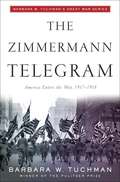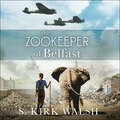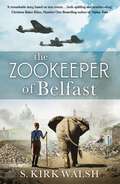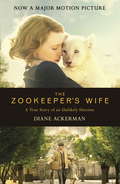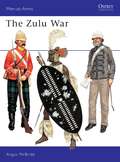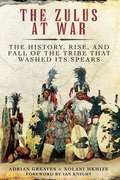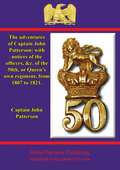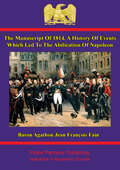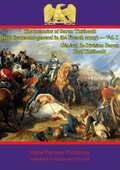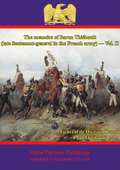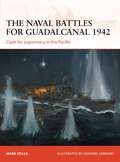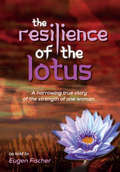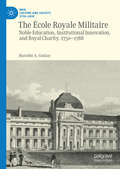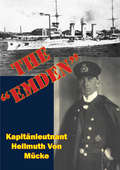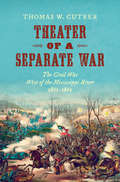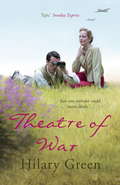- Table View
- List View
The Zimmermann Telegram
by Barbara W. TuchmanIn January 1917 when World War I was deadlocked, the British intercepted a telegram from Berlin, which they knew would bring America to the aid of the Allies. This is the story of how the message was decoded and how it was put to use by the British.
The Zimmermann Telegram
by Thomas BoghardtBy the winter of 1916/17, World War I had reached a deadlock. While the Allies commanded greater resources and fielded more soldiers than the Central Powers, German armies had penetrated deep into Russia and France, and tenaciously held on to their conquered empire. Hoping to break the stalemate on the western front, the exhausted Allies sought to bring the neutral United States into the conflict.A golden opportunity to force American intervention seemed at hand when British naval intelligence intercepted a secret telegram detailing a German alliance offer to Mexico. In it, Berlin's foreign secretary, Arthur Zimmermann, offered his country's support to Mexico for re-conquering "the lost territory in Texas, New Mexico, and Arizona" in exchange for a Mexican attack on the United States, should the latter enter the war on the side of the Allies. The British handed a copy of the Telegram to the American government, which in turn leaked it to the press. On March 1, 1917, the Telegram made headline news across the United States, and five weeks later, America entered World War I.Based on an examination of virtually all available German, British, and U.S. government records, this book presents the definitive account of the Telegram and questions many traditional views on the origins, cryptanalysis, and impact of the German alliance scheme. While the Telegram has often been described as the final step in a carefully planned German strategy to gain a foothold in the western hemisphere, this book argues that the scheme was a spontaneous initiative by a minor German foreign office official, which gained traction only because of a lack of supervision and coordination at the top echelon of the German government. On the other hand, the book argues, American and British secret services had collaborated closely since 1915 to bring the United States into the war, and the Telegram's interception and disclosure represented the crowning achievement of this clandestine Anglo-American intelligence alliance. Moreover, the book explicitly challenges the widely accepted notion that the Telegram's publication in the U.S. press rallied Americans for war. Instead, it contends that the Telegram divided the public by poisoning the debate over intervention, and by failing to offer peace-minded Americans a convincing rationale for supporting the war. The book also examines the Telegram's effect on the memory of World War I through the twentieth century and beyond.
The Zookeeper of Belfast: A heart-stopping WW2 historical novel based on an incredible true story
by S. Kirk WalshA stunning World War Two novel for fans of Natasha Lester, Heather Morris, Kate Furnivall, Mandy Robotham, based on a true story.As the bombs rain down on the city, Belfast's first ever female zookeeper must fight to save the baby elephant in her charge in this gripping, uplifting tale based on a true story.1941. With the men away fighting, animal-lover Hettie Quin is made Belfast Zoo's first ever female zookeeper. She is put in charge of Violet, a three-year-old Indian elephant, and they soon form a special bond. With Violet at her side, Hettie can almost escape the grim reality of her life: the father who has abandoned her family; the sister who recently died; the war that's raging hundreds of miles away.But the devastation of war is closer than she thought. When the bombs begin to rain down on the city, Hettie must gather all her courage to protect those she loves the most. Can she save Violet - and get through unscathed herself?Based on a true story, The Zookeeper of Belfast is a gripping and uplifting tribute to what one woman's courage and tenacity can achieve in the most dire of circumstances - perfect for fans of Heather Morris, Natasha Lester, Kate Furnivall, Mandy Robotham and Fiona Valpy.Praise for THE ZOOKEEPER OF BELFAST:'Walsh delivers a turbulent portrait of life in a divided city . . . A unique perspective of a country at war and the lengths people will go for those they love.' - Kirkus Reviews'Sensitively rendered and finely drawn, this remarkable story, based on true events, is both uplifting and heartbreaking.' - Christina Baker Kline, #1 New York Times bestselling author of Orphan Train'Walsh has written a novel of deep affection and knife-edge suspense. A brilliant debut.' - Margot Livesey, author of The Boy in The Field'An elephant, a young zookeeper, the city of Belfast, bombings, and an IRA member are the improbable characters in this captivating and intimately felt novel that tells the story of a young woman's uncommon devotion and courage under fire.' - Lily Tuck, author of Sisters'A zoo in wartime Belfast and a young woman's fierce love for the elephant in her care come vividly to life in this beautiful, beguiling, and atmospheric debut novel.' - Dominic Smith, author of The Last Painting of Sara de Vos·Cinematic in scope and brimming with emotion, this is a soaring work of historical imagination.' - Karen Olsson, author of All the Houses(P) 2021 Hodder & Stoughton Ltd
The Zookeeper of Belfast: A heart-stopping WW2 historical novel based on an incredible true story
by S. Kirk WalshAs the bombs rain down on the city, Belfast's first ever female zookeeper must fight to save the baby elephant in her charge in this gripping, uplifting tale based on a true story.1941. With the men away fighting, animal-lover Hettie Quin is made Belfast Zoo's first ever female zookeeper. She is put in charge of Violet, a three-year-old Indian elephant, and they soon form a special bond. With Violet at her side, Hettie can almost escape the grim reality of her life: the father who has abandoned her family; the sister who recently died; the war that's raging hundreds of miles away.But the devastation of war is closer than she thought. When the bombs begin to rain down on the city, Hettie must gather all her courage to protect those she loves the most. Can she save Violet - and get through unscathed herself?Based on a true story, The Zookeeper of Belfast is a gripping and uplifting tribute to what one woman's courage and tenacity can achieve in the most dire of circumstances - perfect for fans of Heather Morris, Natasha Lester, Kate Furnivall, Mandy Robotham and Fiona Valpy.Praise for THE ZOOKEEPER OF BELFAST:'Walsh delivers a turbulent portrait of life in a divided city . . . A unique perspective of a country at war and the lengths people will go for those they love.' - Kirkus Reviews'Sensitively rendered and finely drawn, this remarkable story, based on true events, is both uplifting and heartbreaking.' - Christina Baker Kline, #1 New York Times bestselling author of Orphan Train'Walsh has written a novel of deep affection and knife-edge suspense. A brilliant debut.' - Margot Livesey, author of The Boy in The Field'An elephant, a young zookeeper, the city of Belfast, bombings, and an IRA member are the improbable characters in this captivating and intimately felt novel that tells the story of a young woman's uncommon devotion and courage under fire.' - Lily Tuck, author of Sisters'A zoo in wartime Belfast and a young woman's fierce love for the elephant in her care come vividly to life in this beautiful, beguiling, and atmospheric debut novel.' - Dominic Smith, author of The Last Painting of Sara de Vos·Cinematic in scope and brimming with emotion, this is a soaring work of historical imagination.' - Karen Olsson, author of All the Houses
The Zookeeper's Wife: A War Story (Movie Tie-in Editions #0)
by Diane AckermanThe New York Times bestseller now a major motion picture starring Jessica Chastain. 1939: the Germans have invaded Poland. The keepers of the Warsaw zoo, Jan and Antonina Zabinski, survive the bombardment of the city, only to see the occupiers ruthlessly kill many of their animals. The Nazis then carry off the prized specimens to Berlin for their program to create the “purest” breeds, much as they saw themselves as the purest human race. Opposed to all the Nazis represented, the Zabinskis risked their lives by hiding Jews in the now-empty animal cages, saving as many as three hundred people from extermination. Acclaimed, best-selling author Diane Ackerman, fascinated both by the Zabinskis’ courage and by Antonina’s incredible sensitivity to all living beings, tells a moving and dramatic story of the power of empathy and the strength of love. A Focus Features release, it is directed by Niki Caro, written by Angela Workman.
The Zookeeper's Wife: A War Story (Thorndike Biography Ser. #0)
by Diane Ackerman<P>The New York Times bestseller: a true story in which the keepers of the Warsaw Zoo saved hundreds of people from Nazi hands. After their zoo was bombed, Polish zookeepers Jan and Antonina Zabinski managed to save over three hundred people from the Nazis by hiding refugees in the empty animal cages. With animal names for these "guests," and human names for the animals, it's no wonder that the zoo's code name became "The House Under a Crazy Star." <P>Best-selling naturalist and acclaimed storyteller Diane Ackerman combines extensive research and an exuberant writing style to re-create this fascinating, true-life story--sharing Antonina's life as "the zookeeper's wife," while examining the disturbing obsessions at the core of Nazism. <P><b>Winner of the 2008 Orion Award.</b> <P><b>A New York Times Bestseller</b>
The Zookeeper's Wife: An unforgettable true story, now a major film (Movie Tie-in Editions Ser. #0)
by Diane AckermanIn war-torn Warsaw, a zookeeper and his wife refuse to surrender... Now a major motion picture starring Jessica Chastain and Daniel Brühl, Diane Ackerman's The Zookeeper's Wife is based on a remarkable true story of bravery and sanctuary during World War II. Perfect for fans of Lion and Hidden Figures. 'I can't imagine a better story or storyteller. The Zookeeper's Wife will touch every nerve you have' -Jonathan Safran Foer, author of Everything is Illuminated When Germany invades Poland, Luftwaffe bombers devastate Warsaw and the city's zoo along with it. With most of their animals killed, or stolen away to Berlin, zookeepers Jan and Antonina Zabinski begin smuggling Jews into the empty cages.As the war escalates Jan becomes increasingly involved in the anti-Nazi resistance. Ammunition is buried in the elephant enclosure and explosives stored in the animal hospital. Plans are prepared for what will become the Warsaw uprising. Through the ever-present fear of discovery, Antonina must keep her unusual household afloat, caring for both its human and animal inhabitants - otters, a badger, hyena pups, lynxes - as Europe crumbles around them.Written with the narrative drive and emotional punch of a novel, The Zookeeper's Wife is a remarkable true story. It shows us the human and personal impact of war - of life in the Warsaw Ghetto, of fighting in the anti-Nazi resistance. But more than anything it is a story of decency and sacrifice triumphing over terror and oppression. What readers are saying about The Zookeeper's Wife: 'Beautifully and sensitively written - a must read''An adventure that inspires''Both horrifying and endearing on a scale I've not experienced in years''A story that will haunt you forever''Haunting, life affirming, sad, and inspiring'
The Zulu War
by Angus McbrideBy the end of the nineteenth century the fame of the Zulu was world-wide, and their army was one of the few non-European military organizations to have become the subject of serious historical study. Their very name is still synonymous with bravery, discipline and military skill. This excellent addition to Osprey's Men-at-Arms series tells the story of the Zulus at war, from their rise to unrivalled power under the fearsome Shaka to the final devastating defeat against the British at Ulundi, detailing Zulu weapons and tactics, and the famous battles in which they fought.
The Zulus at War: The History, Rise, and Fall of the Tribe That Washed Its Spears
by Adrian Greaves Xolani MkhizeBy tracing the long and turbulent history of the Zulus from their arrival in South Africa and the establishment of Zululand, The Zulus at War is an important and readable addition to this popular subject area. It describes the violent rise of King Shaka and his colorful successors under whose leadership the warrior nation built a fearsome fighting reputation without equal among the native tribes of South Africa. It also examines the tactics and weapons employed during the numerous intertribal battles over this period. They then became victims of their own success in that their defeat of the Boers in 1877 and 1878 in the Sekunini War prompted the well-documented British intervention. Initially the might of the British empire was humbled as never before by the shock Zulu victory at Isandlwana but the 1879 war ended with the brutal crushing of the Zulu Nation. But, as Adrian Greaves reveals, this was by no means the end of the story. The little known consequences of the division of Zululand, the Boer War, and the 1906 Zulu Rebellion are analyzed in fascinating detail. An added attraction for readers is that this long-awaited history is written not just by a leading authority but, thanks to the coauthor’s contribution, from the Zulu perspective using much completely fresh material.Skyhorse Publishing, as well as our Arcade imprint, are proud to publish a broad range of books for readers interested in history--books about World War II, the Third Reich, Hitler and his henchmen, the JFK assassination, conspiracies, the American Civil War, the American Revolution, gladiators, Vikings, ancient Rome, medieval times, the old West, and much more. While not every title we publish becomes a New York Times bestseller or a national bestseller, we are committed to books on subjects that are sometimes overlooked and to authors whose work might not otherwise find a home.
The adventures of Captain John Patterson: with notices of the officers, &c. of the 50th, or Queen's own regiment, from 1807 to 1821.
by Captain John PattersonCaptain Patterson's adventures are written in a companionable, good natured style which leads the reader through the Peninsular War towards the Pyrenees and Southern France Campaign. This account is filled with much essential information of the campaign and the battlefields, as well as entertaining anecdotes of the author's own experiences and those of his soldiers and comrades. An essential addition to the Napoleonic library of every enthusiast.Author -- Captain John PattersonText taken, whole and complete, from the edition published in London : T. & W. Boone, 1837.Original Page Count - x and 436 pages.
The manuscript of 1814. A history of events which led to the abdication of Napoleon: Written at the command of the emperor, by Baron Fain
by Baron Agathon-Jean-François FainThe 1814 Campaign in France saw Napoleon desperately struggling for survival as the Allies closed in following his defeat at the Battle of the Nations in 1813. Many historians avow that Napoleon's fight to retain his throne and his Empire during the early months of 1814 remain his greatest hour, despite ultimate failure.Along with Napoleon on his lightning campaign were his staff, including Baron Fain, who was Napoleon's secretary. Napoleon would often dictate to his secretaries his musings, correspondence and insights, always at extreme speed and sometimes into the small hours of the night: in short they were privy to his innermost thoughts. After Napoleon's final fall, Fain was given the task of preparing a book to record his experiences and the French point of view of the Campaign. His eyewitness account is an interesting narrative on the battles and military and political events leading to the Emperor's defeat and abdication in 1814.Author -- Baron Fain, Agathon-Jean-François, 1778-1837.Translator -- AnonText taken, whole and complete, from the edition published in London, H. Colburn and co., 1823.Original Page Count - vii, 412 p.Illustrations -- 1 Facsimile.
The memoirs of Baron Thiébault (The memoirs of Baron Thiébault (late lieutenant-general in the French army) #1)
by Arthur John Butler Général de Division Baron Paul-Charles-François-Adrien-Henri Dieudonné ThiébaultGeneral Thiébault was always destined for a career in the military: his father was a professor in the military school in Berlin and a friend of Frederick the Great. Having started as a volunteer in the Revolutionary army, he started to acquire a reputation for his knowledge of military matters and staff work. He was then attached to Army of Italy in 1797, being distinguished for his personal bravery and keen wit, afterward serving under Masséna during the siege of Genoa (1800). His brigade played a pivotal role during the battle of Austerlitz in 1805, bringing significant attention to its commander, as did his work on an instruction book on the function of the army staff. Thiébault felt his service merited high office and was disappointed by the advancement of generals of less talent and his posting to the graveyard of the Peninsular, where he served with as much credit as any commander. His memoirs are invaluable for his critical, often biting assessment of his contemporaries and also for his expert commentary on the military matters.His first volume concentrates on his youthful experiences and his service up to the time of the Army of Italy. Author -- Général de Division Baron Paul-Charles-François-Adrien-Henri Dieudonné Thiébault, 1769-1846Translator -- Arthur John Butler, 1844-1910Text taken, whole and complete, from the edition published in New York, The Macmillan Co., 1896.Original Page Count - x and 491 pages.Illustrations - 1 portrait.
The memoirs of Baron Thiébault (The memoirs of Baron Thiébault (late lieutenant-general in the French army) #2)
by Arthur John Butler Général de Division Baron Paul-Charles-François-Adrien-Henri Dieudonné ThiébaultGeneral Thiébault was always destined for a career in the military: his father was a professor in the military school in Berlin and a friend of Frederick the Great. Having started as a volunteer in the Revolutionary army, he started to acquire a reputation for his knowledge of military matters and staff work. He was then attached to Army of Italy in 1797, being distinguished for his personal bravery and keen wit, afterward serving under Masséna during the siege of Genoa (1800). His brigade played a pivotal role during the battle of Austerlitz in 1805, bringing significant attention to its commander, as did his work on an instruction book on the function of the army staff. Thiébault felt his service merited high office and was disappointed by the advancement of generals of less talent and his posting to the graveyard of the Peninsular, where he served with as much credit as any commander. His memoirs are invaluable for his critical, often biting assessment of his contemporaries and also for his expert commentary on the military matters.His second volume relates his experiences during the Austerlitz campaign, in Spain up to the end of Napoleon's reign.Author -- Général de Division Baron Paul-Charles-François-Adrien-Henri Dieudonné Thiébault, 1769-1846Translator -- Arthur John Butler, 1844-1910Text taken, whole and complete, from the edition published in New York, The Macmillan Co., 1896.Original Page Count - 438 pages.Illustrations - 1 map.
The naval battles for Guadalcanal 1942
by Howard Gerrard Mark StilleThe battle for Guadalcanal that lasted from August 1942 to February 1943 was the first major American counteroffensive against the Japanese in the Pacific, it also marks the high point of Japanese expansion and can justly be claimed as one of the major turning points of the Pacific War. While the troops of the US Marine Corps and later the US Army battled the Japanese occupiers on the densely jungled island of Guadalcanal, the US and Japanese naval forces fought a series of tightly contested battles in the waters nearby. The first of these, the battle of Savo Island on the night of 9 August 1942, saw the Japanese inflict a sever defeat on the Allied force, driving them away from Guadalcanal and leaving the just-landed marines in a perilously exposed position. This was the start of a series of night battles that culminated in the First and Second battles of Guadalcanal, fought on the nights of 13 and 15 November, that were narrowly won by US Naval forces and prevented the Japanese from reinforcing their troops on the island to any great extent, and heralded the turning of the tide in the battle for Guadalcanal. One further major naval action followed, the battle of Tassafaronga on 30 November 1942, when the US Navy once again suffered a severe defeat, but this time it was too late to alter the course of the battle as the Japanese evacuated Guadalcanal in early February 1943.This title will detail the contrasting fortunes experienced by both sides over the intense course of naval battles around the island throughout the second half of 1942 that did so much to turn the tide in the Pacific.
The resilience of the lotus
by Eugen FischerThis story tells the sad truth about a young, displaced woman from Manchuria, her life during the Japanese invasion 1931-1945 and some years thereafter. Told to the author in Singapore in the late seventies, it is a harrowing tale of humanity's cruelty and the horrors of war, but also a testament that life always finds a way to survive. Her strength and courage in the horrendous circumstances of war and occupation are inspirational. Like the lotus flower, the human spirit has the potential to grow in the worst environment, and emerge from the muck to bloom again as a beautiful flower. There are so many victims in a war, and once the war is over, one doesn't know their names nor find their graves. The stench of war wilts all flowers. The stench of peace lets them bloom again.
The springs of Virginia: life, love and death at the waters, 1775-1900
by Perceval ReniersVirginia's health resorts from the Revolution to the 20th century.This book presents the Virginia mineral springs. The chief area straddled the continental divide and lay northeast to southwest, with Warm Springs at the top, Gray Sulphur at the bottom, Rockbridge Alum on the east, and Blue Sulphur on the west. The distance between farthest points, either way, was about seventy-five miles. “Almost everyone went in at the Warm Springs and came out the same way” (p. 26). Invalids followed the tour down the center to the White Sulphur for its purging qualities, on to the Sweet for its rehabilitating “tonic,” then to the Salt for its Glauber salt or its iodine, and finally to the Red Sulphur. They then doubled back through the Salt and the Sweet, ending with bathing at the Hot and the Warm (p. 30). But while they sampled the water they also sampled the company, for these were “the fountains most strongly impregnated with minerals, heat, fashion, and fame.” The author presents gaily the various gentlemen innkeepers and how they succeeded or failed; Southern magnates, particularly the South Carolina Singletons and Petigrus and their kin who occupy a substantial portion of the book; Henry Clay, Van Buren, John Tyler; philanthropists like Peabody and Corcoran; and less notable persons from the South, the North, and abroad. Usually Virginians are conspicuous by their absence, except General Lee, and Virginia belles in the more trivial postwar section based on reporters' letters to newspapers.—Journal of American History
The École Royale Militaire: Noble Education, Institutional Innovation, and Royal Charity, 1750-1788 (War, Culture and Society, 1750 –1850)
by Haroldo A. GuízarThis book explores the Paris Ecole Militaire as an institution, arguing for its importance as a school that presented itself as a model for reform during a key moment in the movement towards military professionalism as well as state-run secular education. The school is distinguished for being an Enlightenment project, one of its founders publishing an article on it in the Encyclopédie in 1755. Its curriculum broke completely with the Latin pedagogy of the dominant Jesuit system, while adapting the legacy of seventeenth-century riding academies. Its status touches on the nature of absolutism, as it was conceived to glorify the Bourbon dynasty in a similar way to the girls’ school at Saint Cyr and the Invalides. It was also a dispensary of royal charity calculated to ally the nobility more closely to royal interests through military service. In the army, its proofs of nobility were the model for the much debated 1781 Ségur decree, often described as a notable cause of the French Revolution.
The “Cutty Sark”: The Last of the Famous Clippers [Combined Edition of Two Volumes]
by Dr C. Nepean LongridgeOriginally published in two volumes in 1933, this amalgamated edition provides an in-depth description of the hull, deck fittings, and rigging of this famous ship, together with a detailed account of the building of a scale model, which was added to the collection at the Science Museum in South Kensington, London, England.The first volume gives an account of the ship itself, with plans and full instructions for building the hull, bulwarks, and deck fittings of a scale model.The second volume describes the masts, spars, and rigging of a scale model, and including the builder’s specification for the construction of the original ship.Fully illustrated throughout.
The “Emden”
by Kapitänleutnant Hellmuth Von MückeThe cruiser SMS Emden was part of the German East Asia Squadron based at the Tsingtao in China during the First World War. Designed to be a commerce raider, attacking Allied merchant shipping rather than fleet battle action, she achieved much more than that under the command of her swashbuckling commander Kapitän zur See Karl Friedrich Max von Müller. From the outbreak of hostilities she began to attack the shipping lanes, vital to the Allies, sinking and capturing over 20 vessels in the first few months. She then surprised and sank a Russian cruiser and a French destroyer in the audacious raid on Penang before heading for the Cocos Islands to wreck British naval assets there. Unfortunately for the Emden and her crew, they were hunted down by the more powerful HMAS Sydney and the raider was forced to run aground. The epic efforts of the Emden and her crew are herein brought to life through the memoirs of her First officer, Kapitänleutnant Hellmuth Von Mücke.Following the end of the Emden the majority of the surviving crew were captured, but Von Mücke led a group all the way back to Germany in the commanded schooner Ayesha - this epic journey is told in a companion book the "Ayesha".
Theater of a Separate War: The Civil War West of the Mississippi River, 1861–1865 (Littlefield History of the Civil War Era)
by Thomas W. CutrerThough its most famous battles were waged in the East at Antietam, Gettysburg, and throughout Virginia, the Civil War was clearly a conflict that raged across a continent. From cotton-rich Texas and the fields of Kansas through Indian Territory and into the high desert of New Mexico, the trans-Mississippi theater was site of major clashes from the war's earliest days through the surrenders of Confederate generals Edmund Kirby Smith and Stand Waite in June 1865. In this comprehensive military history of the war west of the Mississippi River, Thomas W. Cutrer shows that the theater's distance from events in the East does not diminish its importance to the unfolding of the larger struggle.Theater of a Separate War details the battles between North and South in these far-flung regions, assessing the complex political and military strategies on both sides. While providing the definitive history of the rise and fall of the South's armies in the far West, Cutrer shows, even if the region's influence on the Confederacy's cause waned, its role persisted well beyond the fall of Richmond and Lee's surrender to Grant. In this masterful study, Cutrer offers a fresh perspective on an often overlooked aspect of Civil War history.
Theatre Shoes
by Noel StreatfeildWhen their father is captured during the war, three children come to London to live with their grandmother and join their talented theatrical family in a school for stage training.
Theatre in Europe Under German Occupation
by Anselm HeinrichThe Second World War went beyond previous military conflicts. It was not only about specific geographical gains or economic goals, but also about the brutal and lasting reshaping of Europe as a whole. Theatre in Europe Under German Occupation explores the part that theatre played in the Nazi war effort. Using a case-study approach, it illustrates the crucial and heavily subsidised role of theatre as a cultural extension of the military machine, key to Nazi Germany’s total war doctrine. Covering theatres in Oslo, Riga, Lille, Lodz, Krakau, Warsaw, Prague, The Hague and Kiev, Anselm Heinrich looks at the history and context of their operation; the wider political, cultural and propagandistic implications in view of their function in wartime; and their legacies. Theatre in Europe Under German Occupation focuses for the first time on Nazi Germany’s attempts to control and shape the cultural sector in occupied territories, shedding new light on the importance of theatre for the regime’s military and political goals.
Theatre of War
by Hilary GreenIt is 1942. The theatres of war are North Africa and Italy. All eyes follow the front, but behind the scenes a messier war continues, an improvised game of snatched triumphs, terrible mistakes and terrifying uncertainty.Cabaret singer by night, spy by day, Richard risks his life to help British servicemen escape occupied France and get back to England. Rose leads a group of dancers with mixed morals high-kicking to entertain the troops as Hitler's bombers roar in the skies above. Then she is given orders to join the forces in the field, destination unknown.Meanwhile a phantom pianist, who has lost the love of his life, is following Montys soldiers across the African desert, mocking the enemies guns by playing Beethoven between the lines.
Theatre of War
by Hilary GreenIt is 1942. The theatres of war are North Africa and Italy. All eyes follow the front, but behind the scenes a messier war continues, an improvised game of snatched triumphs, terrible mistakes and terrifying uncertainty.Cabaret singer by night, spy by day, Richard risks his life to help British servicemen escape occupied France and get back to England. Rose leads a group of dancers with mixed morals high-kicking to entertain the troops as Hitler's bombers roar in the skies above. Then she is given orders to join the forces in the field, destination unknown.Meanwhile a phantom pianist, who has lost the love of his life, is following Montys soldiers across the African desert, mocking the enemies guns by playing Beethoven between the lines.
Their Amish Reunion (Amish Seasons #1)
by Lenora WorthAn ex-Navy SEAL returns to the Amish life—and the woman—he left behind in this inspirational romance series opener by a New York Times–bestselling author.Widowed single mother Ava Jane Graber can’t believe her eyes. Her first love is back in Lancaster County. Years ago, Jeremiah did the unthinkable: left the Amish—and her—for the Navy SEALs. Now the prodigal hero wants redemption from his community, his family and from the woman he never forgot. For the ex-soldier, becoming Ava’s husband is his ultimate mission.
